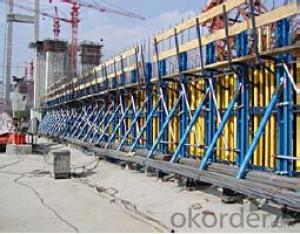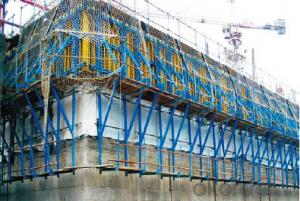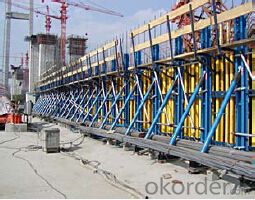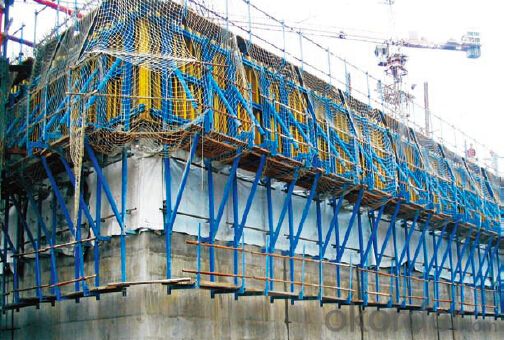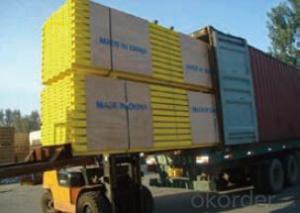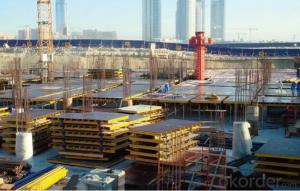Single side climbing bracket for formwork and scaffolding system
- Loading Port:
- Tianjin
- Payment Terms:
- TT OR LC
- Min Order Qty:
- 50 m²
- Supply Capability:
- 1000 m²/month
OKorder Service Pledge
OKorder Financial Service
You Might Also Like
Single-side Climbing Bracket SCB180:
With CNBM SCB 180 climbing systems, the loads from the fresh concrete pressure are
transferred through the brackets by means of V-strongbacks and compression braces into the
scaffold anchors.
Typical applications for the SCB 180 are dams, locks, cooling towers, pier heads, tunnels, and
bank vaults.
The formwork is simply tilted backwards when striking takes place. The 1.80 m wide bracket
requires only a minimum of space.
Characteristics:
◆ Economical and safe anchoring
The M30/D20 climbing cones have been designed especially for single-sided concreting using
SCB180 in dam construction, and to allow the transfer of high tensile and shear forces into the still
fresh, unreinforced concrete. Without wall-through tie-rods, finished concrete is perfect.
◆ Stable and cost-effective for high loads
generous bracket spacings allow large-area formwork units with optimal utilization of the bearing
capacity. This leads to extremely economical solutions.
◆ Simple and flexible planning
With SCB180 single-sided climbing formwork, circular structures can also be concreted without
undergoing any large planning process. Even use on inclined walls is feasible without any special
measures because additional concrete loads or lifting forces can be safely transferred into the
structure.
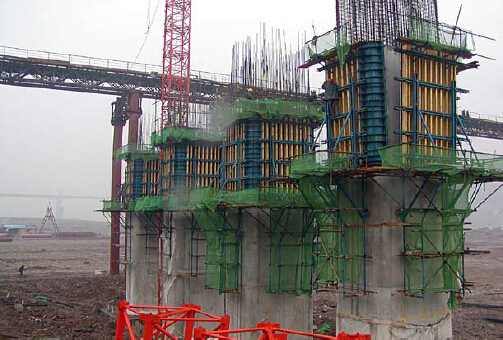
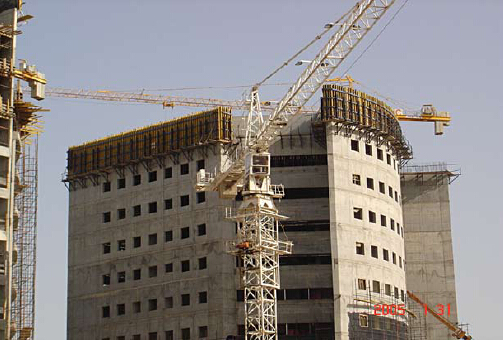
- Q: Can steel formwork be used for elevated helipads?
- Yes, steel formwork can be used for elevated helipads. Steel formwork provides a strong and durable solution that can withstand the weight and impact of helicopters during takeoff and landing. Additionally, steel formwork can be customized to meet specific design requirements, allowing for the construction of elevated helipads with ease.
- Q: Can steel formwork be used for projects with limited formwork budget?
- Yes, steel formwork can be used for projects with limited formwork budget. Steel formwork is a cost-effective option for construction projects as it can be reused multiple times, reducing the overall cost of formwork. It is durable and can withstand high pressure and heavy loads, making it suitable for various types of projects. Additionally, steel formwork provides a smooth finish to concrete structures, eliminating the need for additional finishing work. Therefore, using steel formwork can be a viable solution for projects with limited formwork budget, as it offers long-term cost savings and efficiency.
- Q: How is steel formwork used in construction projects?
- Steel formwork is commonly used in construction projects as a temporary mold or framework to hold wet concrete in place until it sets and hardens. It provides the necessary support and shape for the concrete, allowing it to be poured and molded into desired structures such as walls, columns, beams, and slabs. Steel formwork offers durability, strength, and reusability, making it a preferred choice for large-scale projects that require high-quality finishes and precise dimensions.
- Q: Can steel formwork be used for foundation walls?
- Yes, steel formwork can be used for foundation walls. Steel formwork is a durable and strong material that provides excellent support for concrete during the construction process. It can be used for both horizontal and vertical applications, including foundation walls. Steel formwork offers several advantages such as high load-bearing capacity, reusable nature, and ease of installation and removal. It allows for precise shaping of foundation walls and ensures a smooth and uniform finish. Additionally, steel formwork is resistant to moisture and can withstand harsh weather conditions, making it suitable for foundation walls in various environments.
- Q: Can steel formwork be used for commercial construction projects?
- Yes, steel formwork can be used for commercial construction projects. Steel formwork is a versatile and durable solution that is commonly used in various construction projects, including commercial ones. It offers several advantages such as high strength, long lifespan, and the ability to withstand heavy loads and pressures. Steel formwork is capable of providing accurate and smooth finishes to concrete structures, which is crucial in commercial construction where aesthetics and quality are important. Additionally, steel formwork can be easily assembled, disassembled, and reused, making it a cost-effective option for commercial projects that require repetitive concrete pouring. Overall, steel formwork offers great flexibility and efficiency, making it a suitable choice for commercial construction projects.
- Q: Can steel formwork be used for both monolithic and composite construction?
- Yes, steel formwork can be used for both monolithic and composite construction. Monolithic construction refers to the process of pouring concrete in a single continuous operation to form a solid structure. Steel formwork is commonly used in monolithic construction as it provides a strong and durable support system for holding the concrete in place until it sets and hardens. The steel formwork can be easily assembled and disassembled, making it efficient for monolithic construction projects. Composite construction, on the other hand, involves the combination of different materials to create a stronger and more efficient structure. Steel formwork can also be used in composite construction, especially when the concrete is combined with other materials such as steel beams or columns. The steel formwork acts as a mold for the concrete, allowing it to be poured and shaped around the other materials to create the desired structure. Overall, steel formwork is versatile and can be used in various construction methods, including both monolithic and composite construction. Its strength, durability, and ease of use make it a popular choice for contractors and builders in a wide range of construction projects.
- Q: How does steel formwork compare to wooden formwork?
- Steel formwork is often considered superior to wooden formwork due to its numerous advantages. Firstly, steel formwork is highly durable and can withstand heavy loads and repeated use. It does not warp, crack or split like wooden formwork, ensuring a longer lifespan and reduced maintenance costs. Moreover, steel formwork provides greater accuracy and precision in construction. Its rigid structure ensures that the desired dimensions and shapes are maintained, resulting in better-quality finishes. In contrast, wooden formwork can be more challenging to align and may result in slight variations or imperfections in the final product. Steel formwork also offers increased efficiency and productivity. It can be easily assembled, disassembled, and moved to different locations, reducing construction time and labor costs. Additionally, steel formwork requires minimal cleaning and maintenance, eliminating the need for constant repairs or replacements like wooden formwork. Furthermore, steel formwork is more resistant to moisture and weather conditions. It does not absorb water or warp when exposed to rain or humidity, making it suitable for use in various climates. Wooden formwork, on the other hand, can degrade when exposed to moisture, potentially affecting the structural integrity of the construction. Although steel formwork may require a higher initial investment than wooden formwork, its long-term benefits outweigh the costs. It provides greater durability, accuracy, efficiency, and resistance to environmental factors, making it a preferred choice in modern construction projects.
- Q: What are the different types of supports used in steel formwork construction?
- There are several types of supports that are commonly used in steel formwork construction. These supports are designed to provide stability and structural integrity to the formwork system, ensuring that it can withstand the weight of the concrete during pouring and curing. One of the most common types of supports used in steel formwork construction is the adjustable steel prop. These props are made of adjustable steel tubes that can be extended or retracted to the desired height. They are typically used to support horizontal beams or slabs, and can be adjusted to accommodate different heights and angles. Another type of support used in steel formwork construction is the scaffolding system. Scaffolding consists of a series of metal frames and platforms that are erected to provide a temporary structure for workers to access the formwork. Scaffolding is often used in larger construction projects where multiple levels of formwork need to be supported. Additionally, steel beams and columns can also be used as supports in steel formwork construction. These structural elements are designed to bear heavy loads and provide stability to the formwork system. They are typically used in combination with other types of supports to create a strong and secure formwork structure. In some cases, hydraulic jacks may be used as supports in steel formwork construction. These jacks can be used to provide additional support and ensure that the formwork system remains stable during the pouring and curing process. Overall, the choice of supports in steel formwork construction will depend on the specific requirements of the project, including the size and weight of the formwork, the height and angle of the structure, and the availability of equipment and resources. It is important to carefully consider these factors and select the appropriate supports to ensure the safety and efficiency of the construction process.
- Q: How does steel formwork contribute to the overall thermal insulation of the building?
- Steel formwork does not directly contribute to the thermal insulation of a building. Instead, it is used as a temporary structure for creating the desired shape and structure of concrete elements. The thermal insulation of a building is typically achieved through the use of insulation materials, such as foam boards or mineral wool, which are installed within the walls, floors, and roofs.
- Q: How does steel formwork handle different concrete mix designs?
- Steel formwork is known for its versatility and ability to effectively handle different concrete mix designs. The strength and durability of steel make it a suitable choice for accommodating a wide range of concrete mixes. One advantage of using steel formwork is its capability to withstand the pressure and weight of various concrete mix designs. Whether it is a high-strength mix or a mix with a higher water-cement ratio, steel can handle the load without any deformation or collapse. This makes it perfect for projects that require customized concrete mixes. Moreover, steel formwork ensures a smooth and even surface finish for concrete structures, regardless of the mix design. This is essential for achieving the desired aesthetic appearance of the finished product. Steel formwork guarantees that the concrete is properly contained, preventing any leaks or spills during the pouring process, resulting in a consistent and uniform finish. Additionally, steel formwork can be easily adjusted or modified to accommodate changes in concrete mix designs. Its adaptability allows for efficient construction processes and reduces the need for additional formwork materials. In summary, steel formwork is a reliable and efficient choice for handling different concrete mix designs. Its strength, durability, and adaptability make it an ideal solution for construction projects that require customized concrete mixes. Whether it is a high-strength mix or a mix with specific properties, steel formwork can effectively handle the demands of various concrete designs.
Send your message to us
Single side climbing bracket for formwork and scaffolding system
- Loading Port:
- Tianjin
- Payment Terms:
- TT OR LC
- Min Order Qty:
- 50 m²
- Supply Capability:
- 1000 m²/month
OKorder Service Pledge
OKorder Financial Service
Similar products
Hot products
Hot Searches
